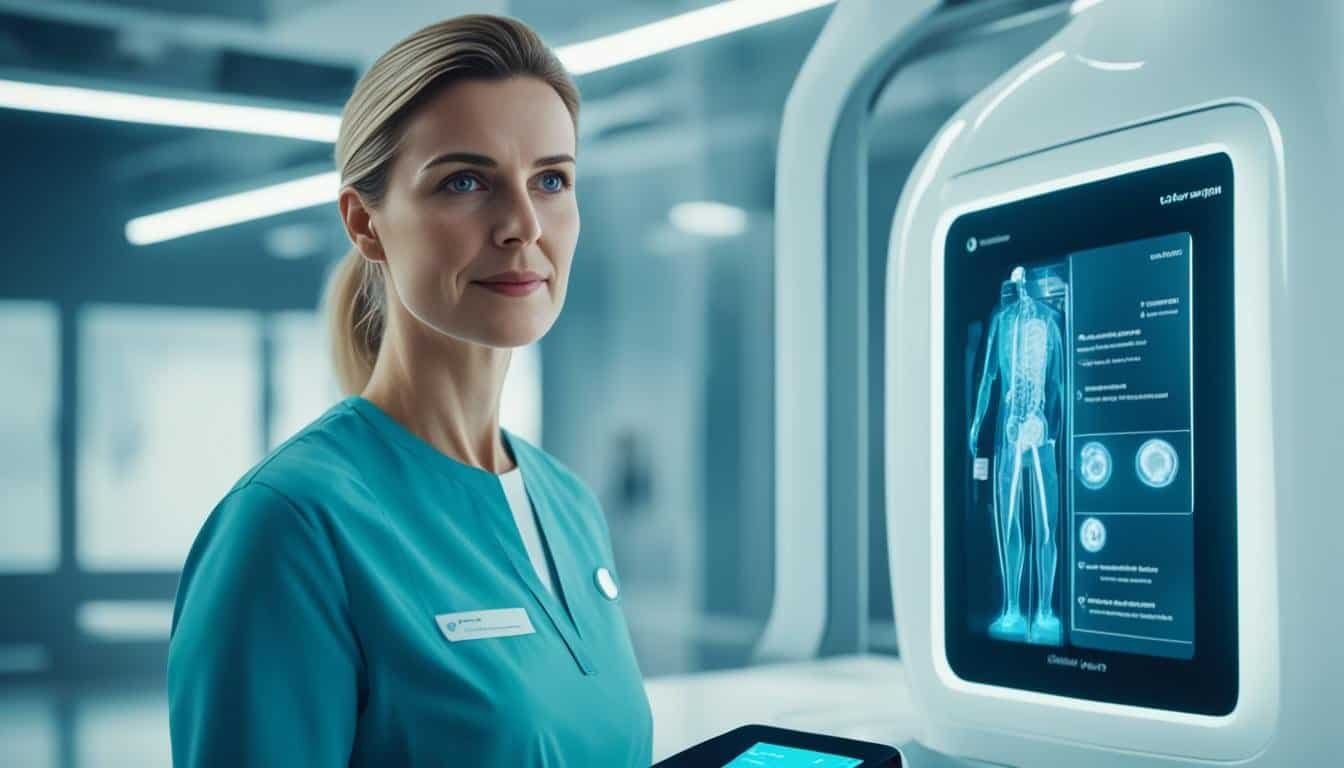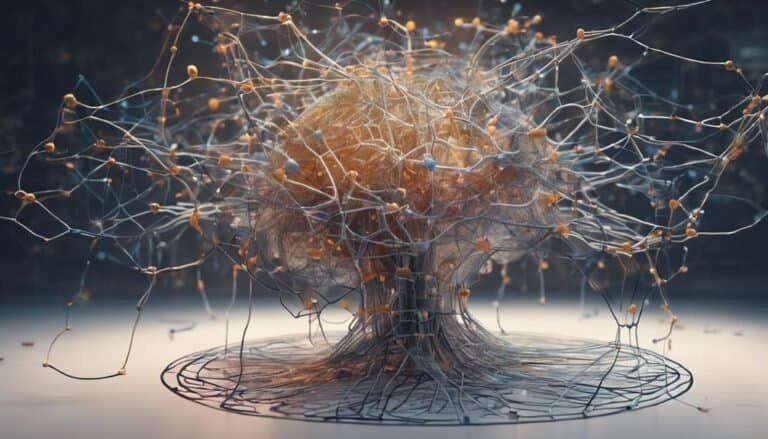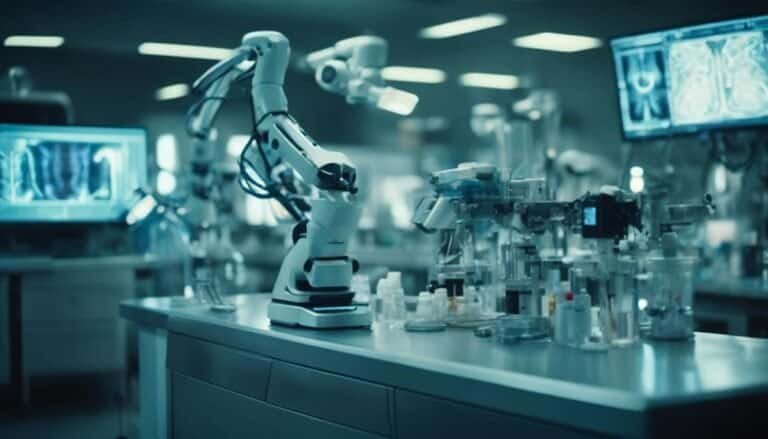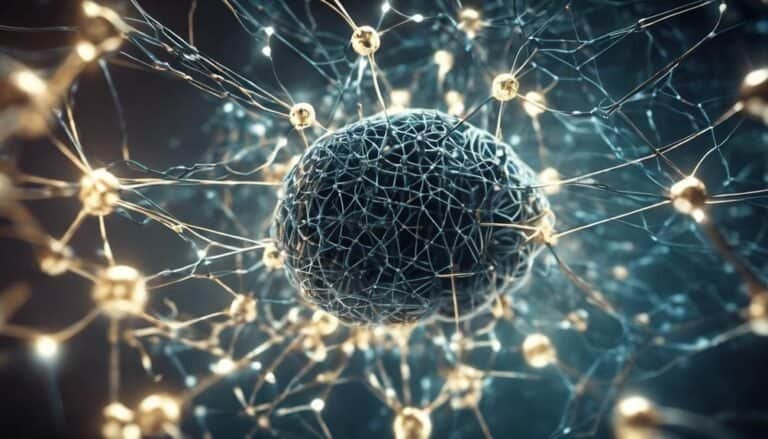AI in Healthcare: Enhancing Cancer Detection Rates with Innovative Technology
Did you know that advanced deep learning algorithms can boost skin cancer detection by an amazing 7639%? This shows the huge potential of Artificial Intelligence in Medicine. AI is changing healthcare, making diagnoses more accurate and treatments quicker.
AI is not just filling gaps; it’s setting new standards in cancer detection. It’s especially good at finding cancer early, thanks to Predictive AI Models for Cancer. These tools help make treatment plans more precise and less harmful, improving patient outcomes.
AI helps doctors understand complex data and spot patterns we can’t see. It’s leading us into a new era in Technology in Oncology. Let’s explore how these technologies are changing cancer care for the better.
Key Takeaways
- Deep learning algorithms have boosted skin cancer detection rates by 7639%.
- AI tools are crucial for early cancer detection and precise risk assessment.
- Machine learning aids in crafting personalized treatment plans, reducing side effects.
- AI enhances diagnostic accuracy in oncology, offering more reliable outcomes.
- Predictive AI models are revolutionizing cancer risk estimation and patient care.
The Growing Role of AI in Cancer Detection
Artificial intelligence is changing healthcare, especially in finding cancer early. It’s key to lowering cancer deaths. AI helps find cancer early in ways we’ve never seen before.
Benefits of Early Detection
AI helps find cancer early by quickly going through lots of medical data. It can look at X-rays, CT scans, and MRIs to spot cancer signs early. This Overcoming Traditional Diagnostics.
Finding cancer early means better treatment chances. It might even mean avoiding more invasive tests. This fits with Precision Oncology goals.
Limitations of Traditional Methods
Old ways of finding cancer have their downsides. Humans can make mistakes, and looking at lots of data takes a long time. AI fixes these problems, making finding cancer faster and more accurate.
This is great news for doctors and for healthcare costs. It helps doctors make better diagnoses and saves money by treating cancer earlier.
Working together, doctors, researchers, and tech experts are making AI better for cancer detection. With more research and better AI, finding cancer early could lead to better health outcomes and more lives saved.
Innovative AI Technologies in Cancer Detection
The use of Innovative AI Technologies is changing how we find and treat cancer. Machine Learning in Cancer Detection helps make finding tumors more accurate and quicker. This is thanks to advanced artificial intelligence (AI).
Machine Learning Algorithms
Machine learning algorithms look through huge amounts of data to find patterns. They use this to predict and help find cancer early. Dr. Abeed Sarker and Dr. Anant Madabhushi are using Machine Learning in Cancer Detection to look at social media and health records. This gives new insights into how patients follow their treatment and how well it works.
Deep Learning in Diagnostic Imaging
Deep Learning in Oncology is changing how we use images to diagnose cancer. AI can look at many images at once to spot cancer cells early. iCAD has looked at over 40 million mammograms with AI, making diagnoses more accurate. The ProFound Risk model is 2.4 times better at finding women at high risk.
Radiomics and Computational Pathology
Radiomics Applications and Computational Pathology Advances show how AI can help with personalized medicine. AI looks at disease patterns at a molecular level. It connects genetic markers with cancer types and outcomes. This helps create treatments that fit each patient better. Sunil Badve and Anant Madabhushi are leading the effort to use AI to predict which breast cancer will spread.
Table 1 shows how AI technologies are changing cancer detection and treatment:
| AI Technology | Application | Impact |
|---|---|---|
| Machine Learning | Analyzing EHR and social media data | Enhanced patient adherence insights |
| Deep Learning | Radiological image processing | Early and precise cancer detection |
| Radiomics | Molecular pattern study | Personalized treatment plans |
| Computational Pathology | Genetic marker correlation | Accurate prognoses and therapies |
| ProFound Risk Model | Mammogram reading | 2.4 times more accuracy in high-risk identification |
These advances show how Innovative AI Technologies are key in finding cancer. They highlight the work of experts from different fields. Together, they’re pushing medical science forward.
How Machine Learning Contributes to Cancer Detection
Machine learning is changing how we find cancer by making algorithms better at spotting cancer patterns and predicting risks. The Machine Learning Impact on medical imaging is huge, making it more accurate and quick to diagnose different cancers. This part looks at how AI uses patterns and predictive models for better cancer detection.
Pattern Recognition in Medical Imaging
AI-driven Pattern Recognition helps analyze medical images deeply, spotting issues missed by old methods. Researchers like Dananjayan and Huang found that advanced algorithms can look at mammograms, MRIs, and CT scans closely. An AI Diagnostic Tool powered by machine learning can find early signs of breast cancer or brain tumors, making diagnoses more accurate.
Predictive Models for Cancer Risk
Artificial Intelligence in Radiology goes beyond just finding cancer. It includes Risk Prediction models. Machine learning looks at risk factors like genes, patient history, and lifestyle to guess a person’s cancer risk. Studies by McKinney et al. showed these models make screening programs better, leading to more targeted and timely actions.
Machine learning is key in fighting cancer today. By using AI for pattern recognition and predictive models, doctors can spot cancer risks early and plan prevention. The growth of AI Diagnostic Tools and Artificial Intelligence in Radiology shows how technology is changing the fight against cancer.
| Study | Focus | Outcome |
|---|---|---|
| Sung et al. (2020) | Global cancer statistics | Incidence and mortality rates for 36 cancers in 185 countries |
| McKinney et al. | AI system for breast cancer screening | Improved detection efficiency |
| Dananjayan & Huang | AI in diagnostic imaging | Enhanced precision in detecting abnormalities |
| Musa et al. | Analysis of AI in cancer research | Systematic evaluation of top 100 cited articles |
AI in Healthcare: Enhancing Cancer Detection Rates with Innovative Technology
AI is changing how we fight cancer. AI for Cancer Detection helps doctors analyze complex data fast and accurately. This leads to quicker and more precise diagnoses. Cancer was behind about 16% of all deaths worldwide in 2022, showing we need better ways to find it.
Every year, 400,000 kids and many adults get cancer. Lung cancer is a big problem, causing 23% of cancer deaths. The IARC says one in five people will get cancer at some point. This highlights the need for Breakthrough Technology in Healthcare.
The Cancer-Moonshot aims to cut cancer deaths in half in 25 years. This shows how crucial AI-Driven Oncology Solutions are for better and more reliable diagnoses. Human doctors often have different views on medical scans, leading to inconsistent results. AI helps fix this, making diagnoses more accurate.
Predictive AI models look at risk factors to predict cancer chances. These are key for early detection, which is vital for treating cancers like breast and cervical cancer effectively. AI helps pathologists make more precise and consistent diagnoses, cutting down on mistakes and improving patient care.
Before, finding cancer meant looking at medical history, doing tests, and using imaging. But, doctors often had different views on these results. Intelligent Cancer Diagnostics with AI fix this, making detection more reliable. These new tools could change how we find cancer, leading to better survival rates and care for patients.
The Impact of Computer Vision on Diagnostic Accuracy
Computer vision in oncology is changing how we diagnose diseases. It uses real-time AI imaging to spot problems with great accuracy. This helps doctors find issues faster and more precisely.
Real-time Imaging Analysis
Real-time AI imaging gives doctors quick insights. It helps them make fast decisions during diagnosis. By looking at images right away, this tech boosts accuracy. It finds cancer early.
CNN-based models are great at spotting tumors. They give oncologists the right info quickly.
Reduction of Human Error
Reducing mistakes in medical imaging is crucial. Human errors can be deadly in cancer diagnosis. Computer vision helps by adding machine precision to doctor expertise.
AI models keep getting better over time. They catch even tiny problems. This teamwork between humans and machines improves accuracy and saves lives.
Early Detection Methods Enhanced by AI
AI technology is changing how we find cancer early, making it easier to treat. It uses advanced algorithms and machine learning to boost screening methods. This is especially true for mammography and low-dose CT scans for lung cancer.
AI in Mammography
AI has made big strides in mammography. It can spot cancerous lesions better than human doctors. AI-enhanced Early Detection tools look at breast cancer screening mammograms more accurately. This leads to finding more cancers and less work for doctors.
Studies in the UK show AI helps lower death rates from breast cancer. This proves AI makes breast cancer screening better.
Low-dose CT Scans for Lung Cancer
Combining AI with low-dose CT scans helps find lung cancer early. AI improves how accurate these scans are. This means doctors can treat cancer sooner and make better decisions.
Using AI in breast cancer screening mammograms shows how AI can change early cancer detection. It also helps improve health outcomes.
The Role of Deep Learning Algorithms in Precision Medicine
Deep learning algorithms are changing how we treat cancer by making treatment plans more personal. They look at complex data to create treatments that fit each patient’s genes. This leads to better results and fewer side effects. AI helps pick the right treatment and watch how patients react, making changes as needed.
Customizing Treatment Plans
Deep learning in medicine lets us create treatments just for each patient. For example, a 2019 study showed how a deep learning model could tell different types of tumors apart. In 2020, deep learning helped improve how we diagnose breast cancer by analyzing images.
| Study Year | Field of Study | Key Findings |
|---|---|---|
| 2017 | Lymph Node Metastases in Breast Cancer | 93% accuracy in diagnostic assessment |
| 2019 | Drug Target Identification | 85% success rate |
| 2020 | Gastric and Colonic Epithelial Tumors | Effective histopathological classification |
Reducing Side Effects
Deep learning algorithms are great at cutting down on treatment side effects. They target cancer cells without harming healthy ones. A 2020 study showed a method that could accurately diagnose cancer, helping to avoid unnecessary treatments.
Using genes to spot early lung cancer, as a 2020 study found, shows how these systems can catch cancer early. Monitoring cancer through DNA, as researched in 2020, helps reduce side effects and improve care for patients.
Revolutionizing Radiomics with Medical AI Applications
The Radiomics Revolution is changing cancer care by using advanced AI. AI in radiomics helps find complex features in images that were hard to spot before. This field is growing fast, with more studies on AI and radiomics in cancer on PubMed from 2016 to 2023.
Data Mining for Better Treatment Outcomes
Data Mining in Oncology is changing the game by giving us deeper insights into images and genes. This helps predict treatment success better. For example, a 3D deep radiomics method was 82.5% accurate in telling if cancer was stable or getting worse in some patients.
Machine learning-based CT radiomics was also very good at spotting different types of bladder cancer. These examples show how AI can help find new, non-invasive ways to diagnose cancer.
- AI-enhanced MRI made finding important prostate cancer spots more precise.
- Radiomics models were great at telling apart different types of kidney cancer.
Integration with Existing Medical Systems
AI is working well with current healthcare systems, leading to better teamwork. Studies show that AI can make cancer detection much more accurate. Radiomics nomograms, which use AI to combine image and clinical data, are also better at predicting cancer outcomes.
“AI in MRI-based detection of prostate cancer has not only reduced unnecessary biopsies but also significantly enhanced treatment decision-making processes,” noted a recent multiline institutional study.
| Application | Outcome | Prediction Accuracy |
|---|---|---|
| 3D Deep Radiomics | Distinguish disease progression | 82.5% |
| ML-based CT Radiomics | Histological variant identification | High |
| Peritumoral Radiomic-based ML | Gleason-grade differentiation in PCa | 0.850 (AUC) |
The Radiomics Revolution is bringing a new era of cancer solutions. By combining AI with healthcare systems, we’re seeing better patient care. This makes cancer treatment more connected and insightful.
Utilizing Computational Pathology for Accurate Diagnosis
Computational Pathology in Oncology is changing how we diagnose and treat cancer. The FDA approved whole slide imaging in 2018, leading to big steps forward. Now, Accurate AI Diagnoses are better than old methods. A 2021 study in the Journal of Pathology showed how an automated prostate cancer system worked well.
Advanced Pathology AI is making it easier to find tumors. For example, the 2016 Camelyon Grand Challenge found 92.4% of tumors with machine learning, while humans found 73.2%. These new tools look for things like cancer cells and blood vessels, making diagnoses more accurate.
A study on melanoma showed how good computer diagnosis is in skin cancer. Since 2017, deep learning has helped classify lung cancer types. This means faster, more precise diagnoses, which is key for treating cancer early.
Now, we’re adding things like clinical info and biomarkers to computational pathology. A 2021 study used deep learning to look at colorectal cancer. In 2019, deep learning systems were really good at finding and grading prostate cancer in slides.
| Technology | Year | Application | Outcome |
|---|---|---|---|
| Whole Slide Imaging | 2018 | Primary Diagnosis | FDA Approval |
| Automated Prostate Cancer Detection | 2021 | Clinical Application | Successful Implementation |
| Deep Convolutional Neural Networks | 2017 | Classification of Lung Cancer Types | Automated Accuracy |
| Deep Learning in Colorectal Carcinoma | 2021 | Histological Feature Quantification | Improved Diagnostic Accuracy |
Conclusion
The future of AI in oncology is moving fast, with big steps in finding and treating cancer. AI has shown it can make healthcare better by making diagnoses more accurate and cutting down on mistakes. For example, a study used the Lunit INSIGHT MMG software to improve breast cancer detection in mammograms.
This shows how AI is leading the way in cancer solutions. Machine learning and deep learning are key to this progress.
Lung cancer, the top cause of cancer deaths, is seeing big changes thanks to AI. AI models like CXR-LC and Sybil are making early detection better. These tools are part of the big change in healthcare technology.
AI has made a huge difference in finding cancer, making tests more accurate. In lung cancer, AI models like LUMAS beat doctors in spotting the disease. This shows how powerful AI can be in healthcare.
As AI gets better and research goes on, its role in fighting cancer will only grow. This new era of cancer care with AI could greatly improve patient outcomes. It shows a strong commitment to making healthcare better.
Source Links
- Artificial intelligence for assisting cancer diagnosis and treatment in the era of precision medicine
- The use of artificial intelligence tools in cancer detection compared to the traditional diagnostic imaging methods: An overview of the systematic reviews
- Artificial intelligence in cancer diagnosis: Opportunities and challenges
- Artificial intelligence and machine learning in cancer imaging – Communications Medicine
- How artificial intelligence is being used to detect, treat cancer — and the potential risks for patients
- The Tech Revolutionizing Cancer Research and Care
- The Quiet Revolution: How AI is Changing Cancer Medicine
- Artificial Intelligence for Cancer Detection by iCAD
- Machine Learning and AI in Cancer Prognosis, Prediction, and Treatment Selection: A Critical Approach
- Artificial Intelligence and Machine Learning in Cancer Research: A Systematic and Thematic Analysis of the Top 100 Cited Articles Indexed in Scopus Database
- Artificial Intelligence in Cancer Research: Trends, Challenges and Future Directions
- Artificial Intelligence in Breast Cancer Diagnosis and Personalized Medicine
- Artificial intelligence in cancer diagnosis and therapy: Current status and future perspective
- Applied Artificial Intelligence in Healthcare: A Review of Computer Vision Technology Application in Hospital Settings
- The Critical Role of Computer Vision in Cancer Treatment
- The Role of Artificial Intelligence in Early Cancer Diagnosis
- Prospective implementation of AI-assisted screen reading to improve early detection of breast cancer – Nature Medicine
- Can Artificial Intelligence Help See Cancer in New Ways?
- Artificial Intelligence in Cancer Research and Precision Medicine
- Artificial intelligence assists precision medicine in cancer treatment
- Emerging Trends in AI and Radiomics for Bladder, Kidney, and Prostate Cancer: A Critical Review
- How Artificial Intelligence Is Shaping Medical Imaging Technology: A Survey of Innovations and Applications
- Artificial intelligence and radiomics: fundamentals, applications, and challenges in immunotherapy
- Artificial intelligence in diagnostic pathology
- Computational pathology in cancer diagnosis, prognosis, and prediction – present day and prospects
- Artificial intelligence and computational pathology – Laboratory Investigation
- Diagnostic capabilities of artificial intelligence as an additional reader in a breast cancer screening program – European Radiology
- Artificial Intelligence and Lung Cancer: Impact on Improving Patient Outcomes







